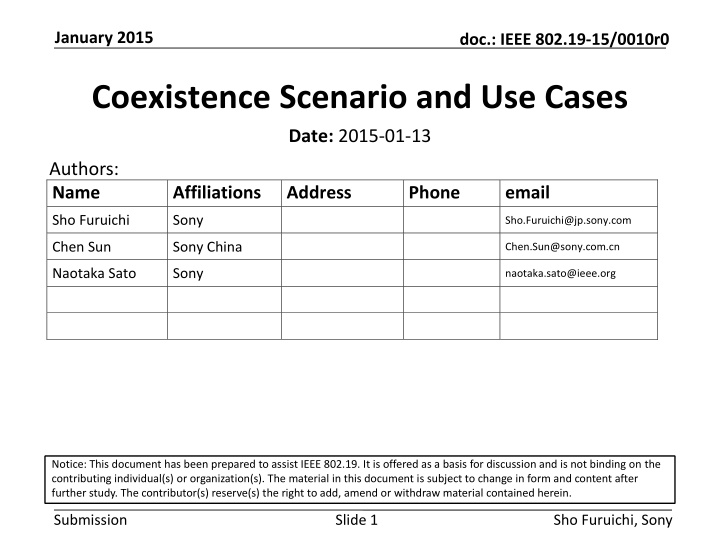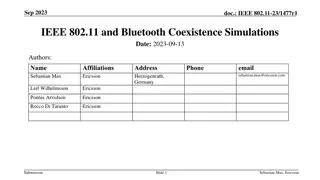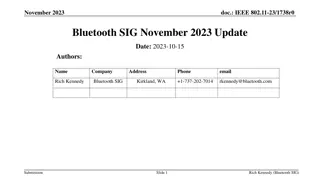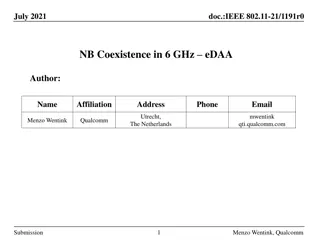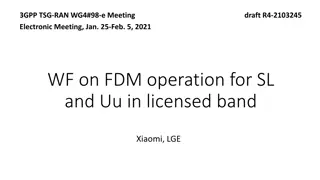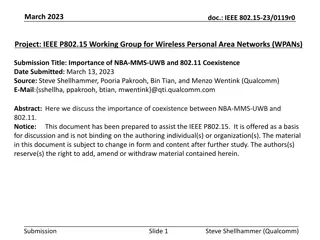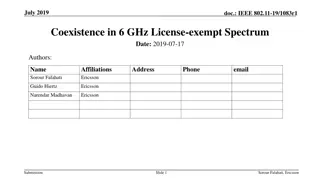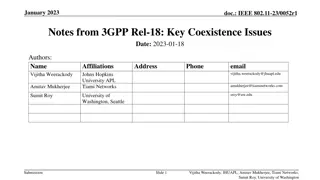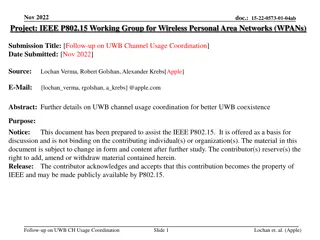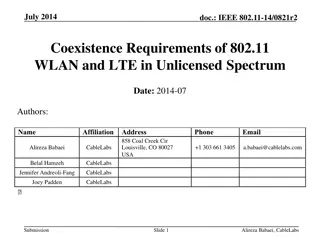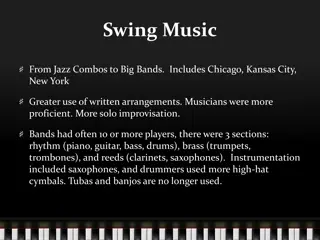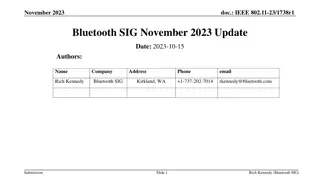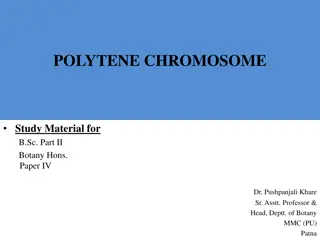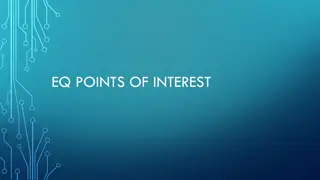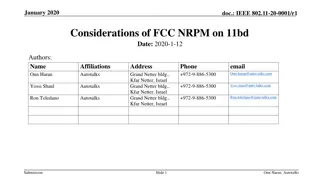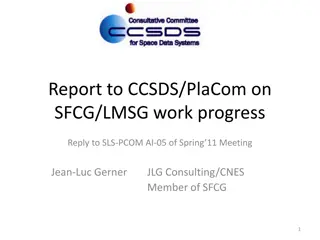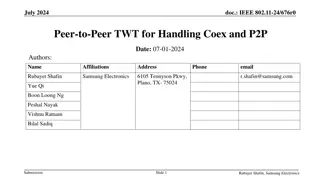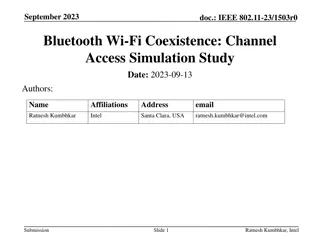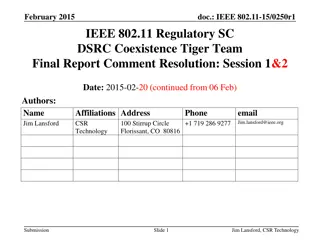Coexistence Scenarios in Unlicensed Frequency Bands Study
The IEEE 802.19-15/0010r0 document from January 2015 outlines the formation of the CUB SG focusing on coexistence use cases between managed and unmanaged RATs, scenarios of unlicensed wireless devices in specific frequency bands, and solutions for coexistence among operators. It also delves into coexistence in TV band whitespace, service types defined in IEEE 802.19.1, and suggests focusing on coexistence scenarios in specific frequency bands.
Download Presentation

Please find below an Image/Link to download the presentation.
The content on the website is provided AS IS for your information and personal use only. It may not be sold, licensed, or shared on other websites without obtaining consent from the author.If you encounter any issues during the download, it is possible that the publisher has removed the file from their server.
You are allowed to download the files provided on this website for personal or commercial use, subject to the condition that they are used lawfully. All files are the property of their respective owners.
The content on the website is provided AS IS for your information and personal use only. It may not be sold, licensed, or shared on other websites without obtaining consent from the author.
E N D
Presentation Transcript
January 2015 doc.: IEEE 802.19-15/0010r0 Coexistence Scenario and Use Cases Date: 2015-01-13 Authors: Name Affiliations Address Phone email Sho Furuichi Sony Sho.Furuichi@jp.sony.com Chen Sun Sony China Chen.Sun@sony.com.cn Naotaka Sato Sony naotaka.sato@ieee.org Notice: This document has been prepared to assist IEEE 802.19. It is offered as a basis for discussion and is not binding on the contributing individual(s) or organization(s). The material in this document is subject to change in form and content after further study. The contributor(s) reserve(s) the right to add, amend or withdraw material contained herein. Submission Slide 1 Sho Furuichi, Sony
January 2015 doc.: IEEE 802.19-15/0010r0 Abstract Coexistence in Unlicensed frequency Band (CUB) Study Group (SG) was formed in the last November. CUB SG should focus on the following coexistence use cases; o Coexistence between managed and unmanaged Radio Access Technologies (RATs) o Coexistence among same/different managed RATs within a single operator o Coexistence between same managed RAT with multiple operators o Coexistence between different managed RATs with multiple operators CUB SG should focus on coexistence scenarios of unlicensed wireless devices operating in the specific frequency bands; o 5GHz U-NII Bands o 3.5GHz Band of United States (US). CUB SG should provide the following solutions o Solution for coexistence between different operators o Unrestricted-RAT solution for any regulatory domains Submission Slide 2 Sho Furuichi, Sony
January 2015 doc.: IEEE 802.19-15/0010r0 Coexistence in TV band Whitespace (TVWS) provided by IEEE 802.19.1 system IEEE 802.15.4m Master Device (AP) Slave Device (Terminal) Registered Location Secure Server (RLSS) IEEE 802.11af Geolocation Database (GLDB) Slave Device (Terminal) Master Device (AP) LTE-Unlicensed Slave Device (UE) IEEE 802.19.1 system Master Device (eNB) IEEE 802.19.1 system can manage spectrum usage of any RATs for TVWS. weightless Slave Device (Terminal) Master Device (AP) Submission Slide 3 Sho Furuichi, Sony
January 2015 doc.: IEEE 802.19-15/0010r0 Service types defined in IEEE 802.19.1[1] Information service o Coexistence Manager (CM) provides the White Space Object (WSO) information about its potential neighbors including their operating frequencies, potential interference levels, etc. Management service o CM provides the WSO reconfiguration requests that create such configuration of this WSO that its operation is improved according to some criteria. Interface C between a CM and a TVWS database is not defined in this standard and is implementation dependent Submission Slide 4 Sho Furuichi, Sony
January 2015 doc.: IEEE 802.19-15/0010r0 Coexistence Scenarios in the specific frequency bands The target band of CUB SG was specified as sub 6GHz, but this is not clear. IEEE 802.19.1 focused on coexistence among unlicensed wireless devices in TV band. We suggest CUB SG focus on coexistence scenarios of unlicensed wireless devices in the specific bands; o 5GHz U-NII Bands o US 3.5GHz Band Submission Slide 5 Sho Furuichi, Sony
January 2015 doc.: IEEE 802.19-15/0010r0 Coexistence Use Cases -System Coexistence use cases to be studied; 1. Coexistence between managed and unmanaged RATs 2. Coexistence among same/different managed RATs within a single operator 3. Coexistence between same managed RAT with multiple operators 4. Coexistence between different managed RATs with multiple operators 3. 1. 2. 4. Submission Slide 6 Sho Furuichi, Sony
January 2015 doc.: IEEE 802.19-15/0010r0 Example 1: Coexistence between IEEE 802 system and non 802 system in 5GHz U-NII Bands Example case o IEEE 802 system: Wi-Fi o Non 802 system: LTE-LAA[2] Licensed spectrum License-exempt spectrum LTE macro cell (e.g. 700MHz) Unlicensed device (LTE small eNB) Necessary to coexist Unlicensed device (802 system AP) IEEE 802 system (5GHz) LTE Small cell (5GHz) Submission Slide 7 Sho Furuichi, Sony
January 2015 doc.: IEEE 802.19-15/0010r0 Example 2: Coexistence in Generalized Authorized Access (GAA) tier in the 3.5GHz Band of US FCC is now making new rule (i.e. Part 96) for a three-tiered authorization framework in the 3.5GHz Band to realize the Citizens Broadband Radio Service [3]. o Incumbent Access, Priority Access and GAA tiers. In the GAA tier, wireless systems operate as unlicensed systems. IEEE 802 systems may be included in the GAA tier. Then, IEEE 802 systems will have to coexist with various non 802 systems, not only among IEEE 802 systems. Submission Slide 8 Sho Furuichi, Sony
January 2015 doc.: IEEE 802.19-15/0010r0 Information exchange Information sharing enables intelligent channel selection/allocation for same and/or different managed RATs Coexistence among different managed RATs within a single operator Expanding network planning to take LTE and managed Wi-Fi access points into account Coexistence between same managed RAT with multiple operators Intelligent information sharing of channel allocations of managed RATs in the 5GHz U- NII Bands (unlicensed) Providing an interrogation mechanism cross operator borders whilst keeping deployment information internal to all involved parties Coexistence between different managed RATs with multiple operators Expanding network planning to take LTE and managed Wi-Fi access points into account Intelligent information sharing of channel allocations of managed RATs in the 5GHz U- NII Bands (unlicensed) Providing an interrogation mechanism cross operator borders whilst keeping deployment information internal to all involved parties Each RAT measures spectrum environment requested by the intra-network (core network) and report its channel information, interference power level, geo-location information, etc. to database managed by operator Submission Slide 9 Sho Furuichi, Sony
January 2015 doc.: IEEE 802.19-15/0010r0 Implementation example of coexistence between different managed RATs with multiple operators [4] Submission Slide 10 Sho Furuichi, Sony
January 2015 doc.: IEEE 802.19-15/0010r0 Regulations in 5GHz Bands Dynamic Frequency Selection (DFS) o Mandatory in UNII-2 bands o No need in UNII-1 and UNII-3 bands Transmission Power Control (TPC) o Mandatory in U-NII 2 bands in EU and Japan o No need in U-NII 2 bands in US Listen Before Talk (LBT) o Mandatory in EU and Japan o No need in US, Korea and China Submission Slide 11 Sho Furuichi, Sony
January 2015 doc.: IEEE 802.19-15/0010r0 Solutions Solution for Coexistence between Operators o Information sharing enables intelligent channel selection/allocation for same and/or different managed RATs Unrestricted-RAT solution for any regulatory domains o IEEE 802 system will have to coexist with various RATs. o Rules related to coexistence/sharing are different among regulatory domains. Submission Slide 12 Sho Furuichi, Sony
January 2015 doc.: IEEE 802.19-15/0010r0 Summary Coexistence scenarios in the specific frequency bands o 5GHz U-NII Bands o US 3.5GHz Band Coexistence use cases o Coexistence between managed and unmanaged RATs o Coexistence among same/different managed RATs within a single operator o Coexistence between same managed RAT with multiple operators o Coexistence between different managed RATs with multiple operators Necessary solutions o Solution for coexistence among multiple operators o Unrestricted-RAT solution for any regulatory domains Submission Slide 13 Sho Furuichi, Sony
January 2015 doc.: IEEE 802.19-15/0010r0 References 1. IEEE Standard Association, IEEE Std 802.19.1-2014 , July 2014 2. 3GPP TSG RAN, RP-141664 Study on Licensed-Assisted Access using LTE , September 2014 3. Federal Communications Commission, GN Docket No. 12- 354 FUTHER NOTICE OF PROPOSED RULEMAKING , April 2014 4. 3GPP LTE-U Workshop, RWS-140010 Requirements and Coexistence Topics for LTE-U , June 2014 Submission Slide 14 Sho Furuichi, Sony
